(A sweetened condensed version for Health Rising)
Thanks to Lissa for providing her disturbing but enlightening version of a severe mold problem in an apparently beautiful house. The deeper Lissa and her husband dug, the worse it got – a cautionary tale for us all. Cort
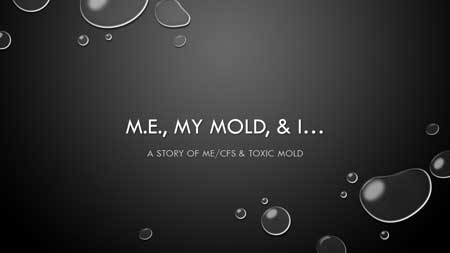
My husband and I were celebrating our 1st Anniversary, and after taking a short hike along the shores of Lake Champlain to watch the sunset, I could barely make it back to the parking lot. I suddenly felt as if gravity was pulling me into the center of the earth. I could barely move my legs, and every cell in my body… j u s t… h a d…. t o…. l i e… d o w n.
My brain was slow and thick, struggling to make sense of things. My speech was slurred, incoming information felt garbled, driving was impossible – my reflexes were slowed, my night vision was atrocious. Sound and light were both excruciating – everything felt like sensory overload. My whole body ached relentlessly. And on top of it all, the exhaustion was completely mind-bending. I had done nothing to warrant such an intense physical and neurological reaction. Instead of walking a few dozen yards, it was as if I had just run two marathons back-to-back, or climbed Mount Everest without oxygen.
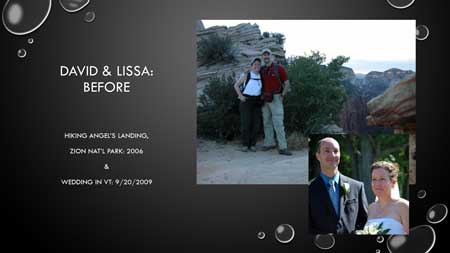
This required a skillset that included the ability to think spatially; to memorize vast amounts (over 3,000 pages) of specifications for coding data; to navigate on the fly – thinking ahead and plotting out the best way to drive all the streets in a neighborhood without backtracking; and also, to be capable of finding creative solutions to any problem that might arise, whether it was “real world” on a road trip, or digitally, to resolve a quirky coding conflict.
Most of these skills and much of the knowledge I’d gained over the years seemed to disappear. I couldn’t remember even the simplest of things, including some basic, entry-level coding of road geometry. (Hard to imagine, when I used to be the regional go-to person for coding extremely complicated areas, like Logan Airport and “The Big Dig” in Boston!) I’d blank out on conference calls when I was asked to report on special projects. I felt panicked about upcoming field work in NYC – I knew my brain wasn’t working right and I was terrified that I’d have a massive fail in front of co-workers who were counting on my experience and skills.
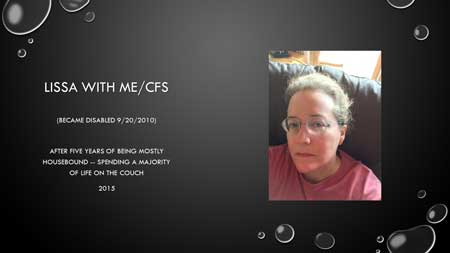
In the beginning, I quickly discovered that regular MD’s had next to nothing to offer. There were no ME/CFS specialists within hundreds of miles, so that wasn’t an option either. I was lucky that my GP actually diagnosed me with ME/CFS right away, but pacing was his best suggestion. That helped to reset my expectations and avoid the worst of crashes, but it didn’t really bring any big gains. (And for POTS… I wore a heart monitor occasionally to keep an eye on my anaerobic threshold. It seemed mostly futile though, because the threshold was so low.)
Then I found a great ND, who discovered that I had almost no amino acids, and severely depleted vitamins and elements of all kinds. After about a year or so of taking bazillions of supplements, including herbal antivirals, and trying various diets, I went from being nearly bedridden to averaging about 20% of my former self and being mostly housebound. I even got a wheelchair for any big excursions, so I wouldn’t feel so left out of life.
Eventually I gained a little more from a combination of correcting my neurotransmitter levels (Dopamine, GABA, etc.), and adding ATP Fuel which seemed to boost my metabolism. Throughout this time I also had passive Yoga Bodywork appointments once a week. This helped with flexibility (I’ve always been super stiff), it improved my rapidly declining posture, and supported lymphatic drainage. Basically it was encouraging gentle movements that I couldn’t do on my own. I’ve found this to be invaluable therapy over the years, and I can really tell the difference when I’ve missed a session.
For several years I seemed to plateau at about 30% of my former self with “good days” getting to 40% or 50%, which were, however, few and far between. Then last year I discovered Mast Cell Activation Syndrome – and treating for that helped even more… for a while anyway. Ditto for SIBO. I went through multiple treatments, low FODMAPS, and even did the Elemental Diet, but within a couple months all the bloating, belching, weight gain, and general yuckiness would always come back with a vengeance.
At the end of last year (2016), I found a new ND who had studied the genetic side of things. She created a finely tuned, specific prescription of supplements based on my own genetics. This makes up for any quirky gene variants that may be preventing proper detoxification and/or methylation. With this avenue of attack — I did see further improvements, but not the leaps and bounds that were expected. Because of this, my doctor asked, “Is there any chance that you’ve been exposed to mold?” That turned out to be the million-dollar question. If only one doctor, of the multitudes I’d seen, had asked me that decades ago! In hindsight, I can now see that I was living in a pattern of relapsing/remitting ME/CFS since childhood.
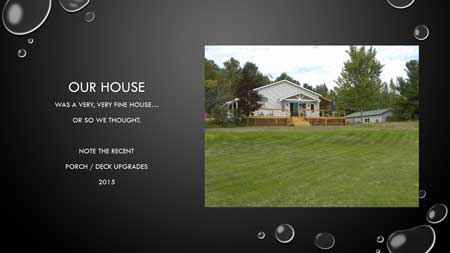
About a year after getting married, we had bought a house (which was only 10 years old at the time), while I was in the midst of the initial pneumonia-like onset. Then I never got better. I really hadn’t pondered that it seemed to coincide with my illness. After all, I’d had a lifetime of bizarre maladies over the years. Nothing would have led me to think that they might ALL be connected… until now.
We had been preparing to finally start a long overdue, master bathroom renovation in mid-February. David was ripping out the vanity and getting ready to demolish the old flooring. When he removed the baseboard behind the toilet he unknowingly unleashed the mother lode of Toxic Black Mold that had been residing there. It was a surprisingly small amount, growing unseen and undetectable in the dark crevice between the baseboard and the tasty surface of the drywall – stealthily wicking sewer water to feed on, up one tiny grout line. Apparently, the toilet had been leaking slowly since the house was built, but it had been so tightly sealed to the floor that there were no signs of water.
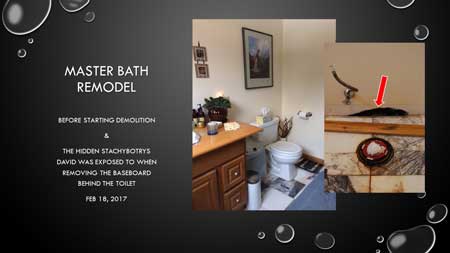
Instinctively we knew it was bad. Really bad. Together we mobilized as best we could and sealed off the master bedroom suite with plastic. It was, in hindsight, fairly ineffective given the real scope of the problem. Then we started researching and trying to figure out what to do next. It sure seemed like we might, indeed, be dealing with the dreaded Stachybotrys – which produces trichothecenes, and go figure…. suppresses the immune system.
Thankfully when all this happened, we already had an appointment scheduled with a Shoemaker mold doctor for the upcoming week. (For once there was actually a local specialist!) She did all the appropriate tests, confirmed the diagnosis of toxic mold poisoning, and prescribed CSM for both of us. Immediately, we set up an appointment with the environmental test guy she recommended. He came out right away and got us started with what would be the first of many return trips for testing the house. (ERMI, air samples, etc. which concluded it was Stachybotrys in the master bathroom.)
We spent hours and hours reading articles about mycotoxins. I joined the Mold Avoiders FB page, and I gleaned all I could from Paradigm Change – a fabulous resource for all things moldy. Instinct told us that we needed to get out of the house right away – despite the test guy not seeming terribly concerned on his first visit.
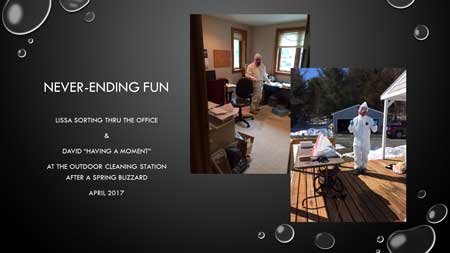
By March 1st we found an apartment in a nearby town, and were able to safely move there with our two cats and not much else. We’d already learned that cross-contamination happens far too easily. What followed for the next month was incredibly chaotic – we spent all our time trying to get our feet under us and replace the absolute basics: clothes, food, a new mattress, and new computers. Our apartment was nearly empty as it was just too risky to bring anything. David even had to trade in his nice truck (that was already paid off) for a beater truck, because the “good” one was making us sick every time we rode in it.
By April we had contracted with a professional remediation company, but it was going to be SO expensive that it was worth our while to try to empty the house ourselves, despite being sick. The mold testing had revealed that it wasn’t just our master bathroom — our entire house was compromised. It turned out that the original builder had made multiple, major construction errors that had allowed moisture into ALL of the exterior walls, where mold was secretly growing in the insulation behind the drywall. The exterior sheathing was rotting — completely unseen, under the cedar shakes. No way of knowing until now, after it had been exposed. So most of the walls around our house contained some flavor(s) of Penicillium/Aspergillus, which produce aflatoxins and ochratoxins.
So, we spent the entire month of April commuting to our own home, wearing Tyvek suits and bright pink respirators, and going through every one of our belongings — chucking things into the giant dumpster, which was parked like a Scarlet Letter beside our house. We rented a storage container for things we tried to save, and vast piles for donation were stuffed in our garage. It took us 2 full weeks, working solid days, every day of the week, plus 4 weekends, before we called “Uncle”, and left the rest of our limited belongings to the professionals. It was an eye-opener to find that most people didn’t understand, and “help” was both limited and hard to come by.
Unfortunately, the remediation company was delayed, and they couldn’t start our job until the 2nd week in May. Enter a long and terrible tale of mistakes and mayhem during the remediation – too long to tell here, as it is already quite the story. In essence, after two full weeks they still weren’t done, because they had to come back and re-do things they had missed or screwed up. By June 1st, we wound up having to spend 10 days in a hotel in Burlington with our cats, because our landlady had rented our apartment already, and the remediation STILL wasn’t done properly. Then even after that, when we got back in to our house “officially” (yet again), we STILL kept finding more stuff the supposed pros had missed. They had to come back again and again, while we hunkered down in the studio once more. The list of what they didn’t find or clean properly was long and cringe-worthy.
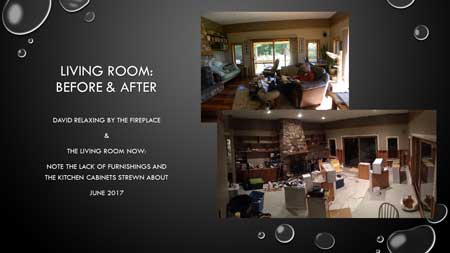
On top of that — through our own sleuthing, we uncovered more toxic mold in the wall under the kitchen window, behind where the sink was. Invisible from either side of the wall — completely hidden within it. We found that not just the kitchen window had failed, but ALL the windows in the house had failed, and were slowly leaking into the wall cavities beneath. Not a peep from the pros. They just painted over the studs in question, and left us with the aftermath. If we hadn’t been paying attention, we would have been sealing things back up and repeating the problem.
Oh — and as if that weren’t enough. In July we found that the attic was contaminated too, so ALL the ceiling insulation and drywall has to be replaced. Thanks again to the builder, who, among the trillion other mistakes made, also didn’t insulate the can lights that are in the ceilings of every room. The condensation over the first 8 years, before we bought the house, caused hidden mold/toxin damage in the ceilings, behind the lights. So that has been spewing down on us all this time too.
For all our troubles, we have gained an uncanny ability to sense contamination to within a few feet of the source. David is especially fine-tuned now – the most notable symptom for him is that the toxins make his ears ring. I get a weird, split-second, earthquakey, “twitchy-nerve” kind of thing in my legs. It feels like someone tugged a rug underfoot, but there isn’t one.
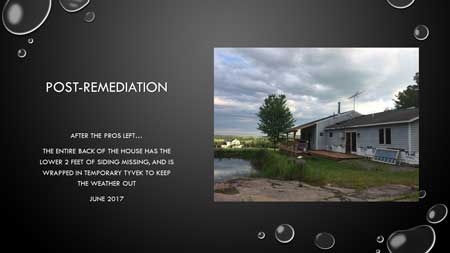
Originally, we chose this house precisely because it shouldn’t have had a mold problem! It has a slab foundation with radiant heat, and no basement. A simple one-story building – it’s built on a hill, snugged up to a mountain, has good southern exposure for sun, and gets cooling breezes coming up the valley. Perfect, right? It now stands there, as a shell of its former self.
The house is completely gutted. The exterior walls are missing the siding 2 feet up, all the way around on the back section, which includes the bedrooms, bathrooms, laundry and mudroom. There is only thin plywood sheeting, covered in temporary Tyvek house wrap and tape to protect it from the weather until we can fix it properly. Likewise, the house is missing the bottom 4 feet of drywall and insulation on the inside of all the exterior walls.
The wood flooring and carpets were all ripped out, so nothing is left but the cement slab floor, and some tile that was in the mud room and laundry. We also had to toss all of our appliances, laundry machines included, due to contamination. There is absolutely nothing left of the kitchen – all the cabinets were contaminated with toxins (which bond to grease), so they have to be refinished in an attempt to save them.
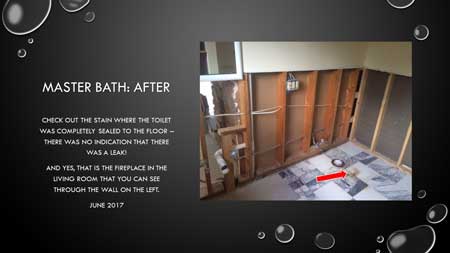
On top of all that, we were left with no functional bathrooms. The master bath was gutted. It has a tub still, but nothing else and no ceiling above the room. The guest bath still has a shower stall, but they originally left us with no toilet, and no sink. (Now fixed thankfully!) We had been using a port-a-potty rental since March to get by. Prior to that, when we were trying to live in the studio back in February, we resorted to peeing in snowbanks. Fun times for a Vermont winter – and oh so thankful we live in a rural area at least!
Now here we are – seven months later, having paid an astronomical tab for the remediation, and THIS is what we were left with. We can’t start putting things back together, because of the issues that remain within the exterior walls, as well as the attic, and all the failed windows.
By late August, even living outside, cooking on the side porch, and sleeping in the studio and/or a tent for several weeks was not enough. We had to leave the property again and move into an apartment in South Burlington. Now we are living there full time, it has added 30 minutes to David’s commute, and we still have to deal with regular yardwork, mowing etc. at the house in the meantime.
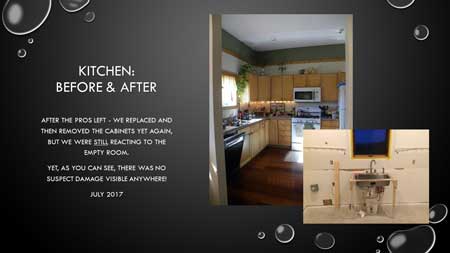
So – being mostly gutted, but needing the remainder to be gutted— the house has lost its value of course. We got sicker trying to live/work on it for the past 3 months. Now we are living in an apartment– paying rent, AND the mortgage. Trying to figure out what to do… And hoping to get a bounce in our health from having left the property…AGAIN.
We are torn because saving the house is overwhelming. But it has a lot going for it, radiant heat on slab, no basement, etc. The problems were ALL from a horrible builder screwing everything up. Putting it back together correctly would fix the issues and we’d know what we have because we did it. I shudder to think of dumping the house and becoming vagabonds — terrified to get involved in real estate again, but still needing a roof over our heads. Blargh.
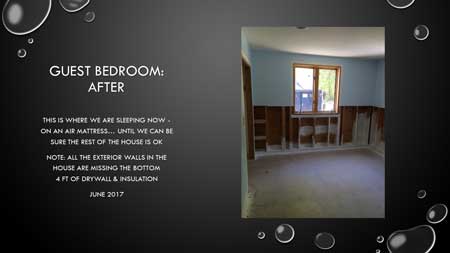
We, in good faith, were going about our lives as homeowners, upgrading the property and house in reasonable DIY increments — all the while getting sicker from the hidden mold. It’s crazy making to think we may lose what we thought was our dream home because of other people’s negligence…. and to have no recourse!! We feel like lost souls without a clue how to solve this.
Did I mention that insurance doesn’t cover a penny?! What about IRS – catastrophic loss?! NOPE. Same response as the insurance company… a “slow” issue is YOUR problem. Not only that – the statute of limitations ran out 6 months prior to exposing the toxic mold, so supposedly we have no recourse through the court system either. Even using the “discovery rule”, no lawyers have been willing to take our case on contingency. We can’t afford to put our house back together, let alone pay a legal team out of pocket.
UGH. So, special thanks goes to the incompetent builder, the seller who lied about mold, and the state of Vermont for not having any building codes. Oh, and a very special kind of thank you for home insurance, the bastards that write the clauses to exclude mold, making sure there is no help to be found.
In any case, we both improved after leaving the house and moving to the (1st) apartment. I seem to have had the most significant gains overall. Although David feels somewhat better too, he was more compromised by his acute exposure and he also happens to have the double whammy HLA genetics. Unfortunately, because we are super sensitized now, and still being exposed – even at minute levels, we are both still struggling to make better progress.
I kept ME/CFS symptom records for years, and also had been using a Vivofit fitness watch to record my activity (or rather lack of). For the past two years that I’ve worn it I averaged about 4,000 steps a day. Since getting out of the mold, I am regularly doubling that count, and I’ve even had a few days that I topped 14,000 steps. And I wasn’t even thinking about it or trying!

More recently, since we’ve been in the new apartment for almost a month now, we are definitely doing better than we did at the house. However – we are not in the clear by any means. We are still not feeling as well as we did the first time we got out. As of yet we haven’t been able to determine why. There are far too many variables still… is it cross contamination? Slow detoxing? Contamination or VOC’s from the new apartment? Is it contamination from neighbors? Shared laundry facilities? Is it something from the pine woods behind the apartment complex? It is truly crazy making.
On a lighter note, we are so lucky to have each other, and to have the same mind-set about working together to get our lives back. David has seen me through thick and thin, and now that he is experiencing some of the same, he has an even fuller understanding of all I’ve endured, and vice versa. I know exactly what he’s going through too. Thankfully we have been weathering the storm as well as we can. The glimmers of health we’ve seen already from avoiding mold have brought us much hope for the future.
Most of all, we are both determined to follow through by telling our story to anyone and everyone who will listen. The more we learn, the more we know; the more we wonder, the more we research; and the more we realize just how HUGE this mold thing really is. It’s unfortunate that people don’t tend to really understand things until they’ve experienced it themselves… we can speak to our own former ignorance, and we hope to raise awareness to help others.
______________________________________
It’s a story one wouldn’t wish on one’s worst enemy. I asked Lissa knowing what she now knows what she would have done differently.
Looking back what would you have done differently regarding buying the house? Is there any way to protect yourself against something like this happening?
In hindsight we definitely would have gotten professional mold testing done before purchasing the property. It was a mistake to think that not seeing or smelling anything meant it was OK. (And just a side note — those DIY Box Store kits are NOT good enough. ERMI and multiple sampling methodologies are the way to go. Our tester did the right tests, he just missed a bunch of issues, and glossed over some slightly suspicious results.)
I would also have done a more thorough investigation when seeking a professional air quality specialist. We went with a person who was highly recommended by our Shoemaker doctor – yet we did not think to check what types of certifications were the “gold standard” in the business. Because we were in a rush to find answers, when the guy seemed knowledgeable, we automatically trusted him without looking any further. It certainly would have behooved us to slow down and seek out advice from online groups that already had experience with finding reputable testers.
Not to mention, it also would have been helpful to look up what types of associations a good professional might be a member of, to ascertain competence — and to make sure there was a thorough understanding of exactly how poisonous toxic mold is. I’m sure the guy we hired was very good, for the average house or person. But our case was so extreme, we should have been advised to handle things very differently from the beginning. Their standards seemed to pertain more to flood damage, and using that mode of thinking for the remediation is what left us with contaminates still in the upper halves of the walls.
What would you have done differently regarding remediation?
Wow – maybe the same kind of answer as for the air quality testing – we should have done a more thorough investigation of standards and company backgrounds. We automatically went with one of the companies that our Shoemaker doctor had listed. The problem was that although they did a good planning report, they were woefully under-educated on the realities of making a house safe for people who already have compromised health.
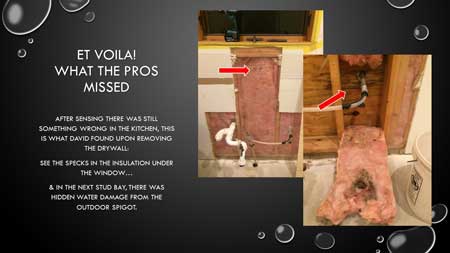
What resources can you suggest for people concerned with mold issues in their house?
First and foremost — I’d suggest stop Googling “mold” and use the word “mycotoxin” instead. You will find enormous amounts of research and articles all backing up the fact that the toxins from mold are extremely harmful to both humans and animals. Some are even used as biological weapons….
It is unconscionable that so many websites (notice that it is mostly govt, insurance, pharmaceuticals, and allopathy… saying this!) can spout that mold is harmless and can only cause allergies. NONSENSE. It is a well-known and published fact that mycotoxins come in many flavors and can cause immunosuppression and all kinds of neurological damage, as well as affecting multiple organs. Start reading, and keep asking questions. I promise you will be profoundly affected by the reality of it all.
A few websites for starters:
- http://paradigmchange.me/
- https://www.truthaboutmold.info/world_health_organization
- https://www.globalindoorhealthnetwork.com/
There are also several high quality Facebook groups that revolve around Mold Avoidance… I strongly suggest joining one, as they are full of information as well as people sharing their experiences. It helps to not feel so alone! (Don’t we all know that already, as members of HR!)
And if you haven’t already – go read Julie Rehmeyer’s book, Through the Shadowlands!
Now for the cringe-evoking question. How much have you sunk into this?
We’ve lost almost all of our belongings…. Cost? Priceless. I have close to a thousand books – a lifetime’s collection – that are now in storage, but most likely contaminated. I can’t bear to part with them – yet anyway. Most of our furniture is gone. Large appliances we had just replaced, thinking the house was clean…. Now have to be replaced again because of contamination.
We paid around $6,000 for the multiple air quality tests — and re-tests. The remediation tab was $22,000. And that was down by $8,000 from the first estimate because we mustered, burned through three weeks of David’s vacation time, so we could do a majority of the cleaning/dumping/destroying of our belongings ourselves… and with some help from David’s parents as well as a couple of his friends. (Huge thanks to them!!)
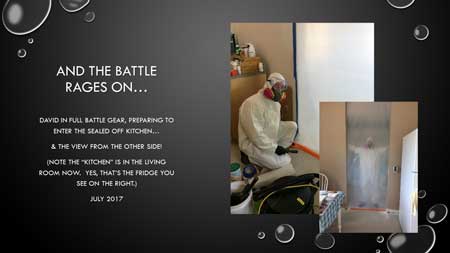
We took out a home equity loan for $50,000 when this all started, assuming that we’d be ready to fix the house back up after the remediation was successful. Now it will take even more money and materials than originally planned, to gut it even further and then put it back together again. (To hire a contractor and team to do it all — now wouldn’t THAT be delightful?!) It will take a significant chunk of change – beyond our life’s savings, that we’ve already been setting fire to. A rough estimate at this point is around $150,000 for a full rebuild with paid labor. (Keep in mind, it’s certainly not California, but Vermont is kinda pricey! It’s truly a modest house of about 1800 sq ft, one story with no basement.)
The grand total is truly overwhelming… all in all this disaster easily has a price tag of close to $300,000 in losses/expenses – and that is just from trying to save the house. Because we haven’t owned it that long, we still owe a significant chunk on the mortgage – and if we try to sell the house “as is”, we’d take a huge hit by trying to dump it. Suffice it to say we are at wits end.
What about crowdfunding to support you guys? Is that a possibility?
We have been tossing around the ideas of crowdfunding — and are unsure where to start. Never thought we’d be in this position, and to be honest it has been hard to think about when so many are suffering with the hurricanes and all. GAH. In comparison, we are so “lucky” in so many ways. But we’ve also been screwed beyond compare, through a ridiculous chain of atrocities.
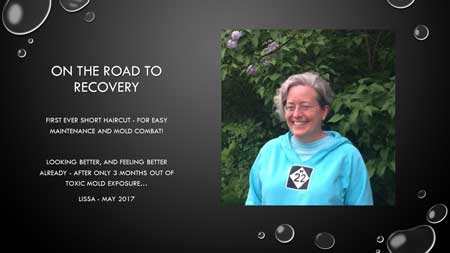
________________________________________
More Mold Stories and Resources on Health Rising
Stories
- “Death Rider”: A (Hopeful) Mold Illness Story
- Falsely Diagnosed Fibro-CFS for Nearly Ten Years – A Mold Recovery Story
- After Spending 200K Joey Finds His (Simple) Solution
- Jeri’s Amazing Discovery
- A ‘Different World’: A Mold Avoidance Success Story From Giles Meehan






Lissa and hubby, I’m there with you. Having my own mold/detox struggles. It’s a long hard journey. Hang tight! Hoping we all get a handle on this and can educate others with our experiences.
Issie
Thanks Issie! I am deeply grateful to you and others on HR for sharing your own stories and comparing notes with me! It has been quite a journey for all of us, as we find our way through this.
I am dealing with the same thing right now. It’s really bad. I am sorry you went through this, it’s been a nightmare I am not in control of my life or health. My entire family is getting sicker I am so weak all the time.
What a story! Lissa, I’m sorry for what you and your husband have gone through. Thanks for writing this for the benefit of others, and thanks to Cort for publishing it. I will pass the article on to others. I look forward to reading the book.
Thanks Merry! Thanks so much for your support — and I second the “thanks to Cort” for all he does! Please do pass the article along — it’s an important dialogue, even if people are reluctant to think about it. We’ve gotta start somewhere!
You have my deepest sympathies for all of your loss and emotional turmoil…..my own story is similar but worse? ….depends on your perspective I suppose…but one thing that I think is particularly problematic especially in the US is the concept of “dream home” its a product of the cultural consciousness of the American dream…. in actuality its a bloody nightmare… I can understand your attachment to books I have given up a couple of thousand …but they can be replaced….did you both have HLA DR typing ? I would be interested to know what tat info told you……it seems the recent trend is to play this information down somewhat so as not to make people think that all action is of no use if you have the dreaded genotypes ….. I believe the total opposite and look at this information as the standard for the type of action one needs to take…as in …..if I had discovered that I had a homozygous 401-3-53 haplotype I would know to get out and leave pretty much everything asap……intead I had years of exposure with no answer and conditions which appear to have become permanent….so I hope you are in a much better place as of this writing and would love to help you if possible ….
kindest regards
Steve
Thanks for what clearly is empathy Steve! I’m so sorry to hear you’ve been down the same road. Losing books — such a nightmare to some of us! I think of it as an archaeological account of our lives… I can pick up any one of these beloved books and recount where I was, why I purchased it, or what important event was happening at that time in my own personal history. They are more than “things” in that way.
IN answer to your HLA questions — my husband had the double whammy – so my understanding is that it means his body will have a much harder time getting the toxins out. Neither of us like to look at it as a “sentence”, as that seems so dark and counterproductive. My own HLA was “multi-susceptible” (meaning toxic mold) and “chronic Lyme susceptible”, making me more likely to get sick from these things. It means I also have issues detoxing, but perhaps not as severe as David.
That said — I would agree with you about it being useful if there were a standard. It sure would be nice to have an entity verify the seriousness and provide a path to health, even if it includes an absolute of ditching your life to get your health back. I do think it would be better to know that up front, rather than be stumbling along wondering if you are doing the right things.
Thanks for your input Steve – I welcome your advice, and appreciate your reaching out!
Lissa and Cort,
Thanks for sharing this story. I so deeply empathize with the struggle you have endured, and the money and possessions lost due to mycotoxin contamination. For me the losses were also about expensive and failed medical treatments for ME/CFS.
I have the genetic predisposition as well as Shoemaker lab tests that indicate mold and mycotoxins are contributing to or causing my ME/CFS symptoms. We left our beautiful but moldy rented town home in Half Moon Bay, California on August 15, after I did Hertsmi testing and consulted with two Shoemaker certified doctors by phone. I had small improvements with taking Cholestyramine just once a day, and I am now up to three times a day. We are not even considering another rental much less buying a home right now. We dispersed of all our belongings except a small uhaul of art work and sentimental items before leaving the town home. We stayed with friends in their newly built home while we replaced all the essentials (phones, iPad, vehicle, clothing) and bought camping gear. We are now living outdoors in pristine air, and I continue to improve in small increments.
If Joey, Erik, Lisa, Sara, Julie, Chris, Ana, etc. had not been willing to share their stories, I wouldn’t have believed that mold avoidance could be done, especially with me functioning at 20% of normal and my husband disabled and recovering from back surgery.
I have to say that getting myself and my home tested was the easy part, and anyone with chronic multi system illness can and should do that, whether they think mold might be a problem or not.
The hard part is actually doing extreme mold avoidance, living outdoors in pristine air, avoiding cross contamination, and detoxing from mycotoxins. We hope that we learned from other people’s mistakes and successes. We hope that I will eventually recover using mold avoidance techniques, the Shoemaker protocol, and additional support (methylation issues and heavy metal detox) from a naturopath as needed. Time will tell. In the meantime, being “homeless” by choice is part of my treatment. It beats the hell out of remaining mostly home bound with disabling symptoms of ME/CFS.
Yes, yes, YES Cheryl! Thank you for sharing your story here. My heart goes out to you — and BRAVO for the extreme avoidance!
I concur with your comment about Joey, Erik, Lisa, Julie, etc. and their willingness to put their stories out there. I think the more we post publicly the more impact we will have in helping others. When it’s happening to so many people, so many places, it starts to seem less crazy. I firmly believe we are reaching a tipping point in awareness. The stories are out there — it’s our job to keep reading and learning!
What I don’t understand is, what about the massive amounts of mold in our gardens or nearby woods and forests? The ecosystem relies on molds as part of the cycle of life, meaning it’s pretty much everywhere, Except Antarctica and deserts.
Living next to a forest surly would expose one to huge amounts of mold. So is there any point in fixing a house with mold when the house is surrounded by natural decaying vegetation. Wouldn’t it be better to shift to a better drier climate with a low mold spore count, than spend thousands on a big renovation job yet the air from outside is contaminated? I’m saying this for people with mold sensitivities to think about before ripping their homes to pieces. Perhaps selling and moving is a cheaper option that insures you are well away from areas with mold in the air anyway.
Yes you make a great point, Brendan. We’ve been thinking the same thing too. Although — there are all kinds of molds, especially those in nature, that don’t produce deadly mycotoxins. So some will harm you and some won’t. The likelihood skyrockets when mold is indoors, because it is trying to out-compete its enemies – like other species that might be growing nearby.
Another component that ups the ante, so to speak, is exposure to toxic chemicals. Household cleaners, insect sprays, Roundup, etc. Mold growing in such conditions can have a field day using these chemicals to create new levels of warfare against its neighbors. The stronger it gets, the more toxic, the more it spews nastiness and kills off any local competitors — which eventually means the 2 leggeds and 4 leggeds in your home!
So I’m not suggesting that the woods are always safe by any means. Just relating that the indoor environment can get very, very potent under the wrong conditions, especially coupled with it being a warm, humid, enclosed space. Generally speaking, nasty molds in the woods are fairly well ventilated and dispersed in comparison, with (hopefully) less access to chemicals.
Unfortunately, I do live in the desert – Phoenix. There is a lot of irrigation here and we have mold too. There is also plant fungus/molds that can cause issues here (Valley fever). Also, because of how dry it is and the dust storms – it blows things around more. There is no perfect place. And then if you have the genetic mutations that get activated and you have exposure – you can’t just eliminate it from your body. I have what was once called Protomyxzoa Rehumatica. It’s now called Glomus mosseae and I also have glomus versiforme. These are plant fungus but were found in a thyroid biopsy. The doctor researching this had also found it in prostate cancer, brain tumor, and heart bypass plaque. To date, he is the only one with his colleagues to have peer reviewed papers published on this. So yes, plant fungus can affect us and get into organs. He says he knows we are missing a certain protein and he knows it’s a genetic defect. So we are waiting for more research from him.
But I also have CIRS and MARCONS. And I have all the worst of the worst genetics for it. 5 bad ones. My story is long and filled with lots of autoimmune issues. I’m seeing a Shoemaker and Klinghardt trained doctor. It’s a slow process for me. Can’t say I’m better yet – but hopeful. And my sister and her son have recently tested positive too. She is in Utah. She also has CFS very bad and is in almost all the research studies that are being done.
Issie
I agree that there’s something about mold in houses that is different although I suspect that in general drier is better. I know that I don’t do as well in Pacific Northwest as in the Southwest.
Of course mold is present everywhere. If you’re ever near a Joshua tree take a close look at the older parts of it – ravaged by mold… I don’t think that’s the kind of mold that gets us.
Good luck Cheryl! Keep in touch and let us know how it goes. The last couple of years has certainly been a kind of watershed in learning what mold can do.
Hello Cheryl,
Did you find a pristine place to live outdoors in a place accessible from the HMB? If so, I would like to know where. I live in Santa Clara and have been trying to find a safe place to live for years. I am too ill to go very far on a first step; want to search the dry SW US when I gain enough health. My efforts include purchasing an off-the grid property in the SC Mts. which was better than Santa Clara, then became worse. I am back to living in SC. Problems from the changed flight paths and/or a fire upwind two(?) years ago. Besides mold, I have MCS, EMF sensitivity and noise sensitivity to deal with. Also, can not be with cats.
Thank you for any info you can send me.
Thank you for sharing this story on mold exposure. I developed ME/CFS, MCS and asthma after teaching in moldy schools. There were no visible signs or smells of molds. The mold was discovered between the roof and ceiling tiles and walls. Is there any test that will tell if you have mold/fungus in your body? Do you know if the toxic mold can damage (through liver, kidneys etc.)our ability to get rid of toxins? Could the flu/infection that triggers ME be a fungal infection? Any doctors studying this? Thanks
Hi Dee – thanks for sharing YOUR story, and posting such good questions!
There is a test for mycotoxins in the body – although it is my understanding that it is quite expensive, not fully reliable (like Lyme tests?), and testing positive or negative may be skewed depending on how much your body is capable of getting rid of. It is a urinalysis — so the way I understand it, what if you got a negative test, but it actually was because your body was struggling to get rid of the toxins. It wasn’t that you didn’t have any — they just weren’t coming out. Please do correct me if I’m wrong here – anyone?
I do know that mycotoxins affect the liver and the kidneys — I am guessing thyroid too because so many of us seem to have the same quirky hypothyroid problems. As for affecting the detox mechanism itself, I don’t know. That sounds like an excellent research question. Ditto for the flu/fungal infection question. YES! This all needs to be studied – in depth. There should be GOBS of research funding to find answers and connect the dots!!! If only….
“A klinghardt trained doctor”……….my advice would be to run or get away as fast as you can from such a perspective…. if it quacks like a duck etc
Steve
She studies with many. She has a wide range of viewpoints and takes pieces from all of them and forms her own protocol/opinions. She is certified Shoemaker mold doc and treats Lyme disease as well. Dr. Jennifer Smith – Scottsdale, AZ. (Some remember Ryans story of mold. We have the same doc.) She is a sweetheart and eager to help.
Issie
I don’t know if anyone is studying fungal infections although I think Lipkin would like to. I don’t see why they would be any different than any other triggering infection. If viruses and bacteria and protozoa like Giardia can trigger ME/CFS why not a fungal infection?
I concur! It makes total sense and should be studied.
Cort, other than Dr Fry and Dr Shoemaker – I don’t know any other research in this area.
Issie
I think there must a mold-related illness which resembles CFS/ME, perhaps marked by pneumonia-like symptoms. That’s certainly not the variant I, or others I’ve known, have. I’ve moved several times over the years and have no chronic lung issues. There is the possibility, of course, that a mold is responsible for the illness at first, and it then remains embedded, but I’ll wait for further research on that one.
Dave, the research is there. See my above post.
Issie
Dave – As Lissa’s husband, going through this experience, I can say with confidence that the manifestations of chronic toxic mold exposure can be all over the map. It can be slow; it can be subtle; it can simply look like getting old. In our case, we got “lucky” by getting a good, solid acute exposure on top of the long-term one. It was certainly a wakeup call. I do NOT have ME/CFS, but Lissa and I do share a whole bunch of similar symptoms – brain fog; vision problems; body aches; “crashes” – though mine are much less severe; skin issues; body temperature regulation, and certain food intolerances.
Interestingly enough, though I’ve got mold allergies, the stuff in our home did not present me with any significant sinus or respiratory symptoms. In my case, the toxins seem to be wreaking havoc on my liver and causing additional blood abnormalities. Though we share the same environmental exposure, the differences in our bodies and genetics bring about somewhat different presentations. Thinking more broadly, when you add in the fact that every environment will have its own special “stew”, combining individuals’ genetics with their specific exposures, it’s not at all surprising that there are so many different presentations.
As far as moving goes, that can be very deceiving. Cross-contamination is every bit the nightmare that the mold avoidance community claims. I’m pretty sure, for example, that I brought contaminated belongings with me when I moved from CT to VT in 2004. It’s only now that we’re piecing it all together.
I don’t agree at all that having moved a number of times and not having chronic lung problems are sufficient reasons to eliminate the possibility that hyperreactivity to mold toxins is a major factor for ME or CFS patients.
If just moving or looking at the presence/absence of respiratory issues was a deciding factor, then this all would have been figured out many years ago.
Unfortunately, this is a much more complex problem than that.
Dear Lissa, Thank you so much for telling your story which resembles mine so much. Mold issues are just hideous. I too have had to get rid of treasures, but I now have chronic lung problems and “central sensitization” that disrupt every part of my life. But in my own research, I learned that the mycotoxins release an alcohol called “one-octen-three-ol” (1-octen-3-ol). This compound interacts with our dopamine supply and is even a factor in the onset of Parkinsons. I contacted the scientist working on this issue, asking which molds could do it. Her response was that virtually every mold releases that. When I think of all the people whose homes have been destroyed by flooding, it just makes me ill. Mold problems lurk in each and every case of that type of catastrophe. I’m so glad that you and your husband were able to understand the extreme sensitivity in each other and keep your marriage safe. Trichothecene molds from a roof leak, compounded by wet wood and carpenter ants eating that wood in our house meant that we stupidly called in a pesticide company, which sprayed a high load of pesticides all over our house for a year. Poisons upon other poisons, of which we were ignorant at the time. Result, a divorce but continuing grave health problems. Sending you courage and praise for all that you have tried to remedy and wishing you the very best, as well as all the mold sufferers which will now be increasing in number, thanks to global climate issues.
Hi Susan! I’m so sorry to hear of your tragic story! What a nightmare. Thanks though, for your uplifting words. I really appreciate it.
I’m fascinated with your research regarding the connection of mycotoxins to dopamine and Parkinsons. We’ve been thinking the same thing, but didn’t know that (1-octen-3-ol) was the culprit there. Wow! We’ve also been looking at trichothecene and its links to immune suppression, protein metabolism, bone marrow issues, skin lesions, and organ damage. The evidence is out there, but not necessarily from traditional medical sources. You’ll get a more accurate picture of mycotoxins and the damage they can do from agricultural & military research.
We have also been worrying over the victims from all the recent hurricanes. Our immediate reaction was that SO MANY MORE people are going to be affected. It is truly beyond comprehension. And if they aren’t getting solid information from the right sources, there is going to be a public health crisis beyond compare. Only the real problem will be that people will be getting sick with all kinds of “random” ailments, not understanding the links to the WDB – Water Damaged Buildings.
It’s maddening that this issue has been closeted in such a way that most people aren’t even receptive to the possibility, until it’s too late and they become immersed in the nightmare firsthand. (Yeah…. that would be us, and now we are learning the hard way, but still intent on helping others.)
If symptoms are truly dose-dependent, then as with any allergen, removing the source of the symptoms should result in a complete recovery. If a theory cannot be falsified, it can’t be relied upon either.
I wonder about this…what if the allergen or offending substance has caused further damage? If it has then why should there be a complete recovery. Maybe think of mold as a kind of toxin. Toxic exposures don’t necessarily lead to full recovery if the toxin is removed.
If you are gentically predisposed and have inability to throw off toxins or your immune system is faulty and it isn’t recognizing that it is foreign and a toxin – you stay sick. Also, with re-exposure the detox starts over. This could be a life long struggle. Depending on your genetics and immune system.
Issie / Cort – The other thing I’d add is that mold toxins are “fat soluble”, as supported by plenty of research. We’ve had an absolute nightmare of a time trying to get our kitchen remediated, due to the toxin laden grease. That stuff is just tenacious. This also means they can accumulate in fatty tissues. I’m guessing this is what makes detoxification such a long, slow process.
So Dave F, what do you think about the docs telling us to use Fish oils to help with the inflammation? My previous doc said it would feed the mold, as would folate, magnesium and most of the B vitamins. I did find some supporting articles. But I’m trying to trust the mold doc and try it her way. I can always stop these things again.
Issie
Issie – For me, the fish oils have been tricky. I understand that the fats are intended to get the gallbladder fired up to produce more bile, which is the mechanism for flushing the toxins. However, in my case, when taking them with CSM at full Shoemaker dosages, they seem to inhibit normal clotting, so I’ve ended up with issues with bleeding/bruising and have done better throttling back. If needed, I just make sure I’m eating plenty of other fats with the associated meal/snack.
Dave F, I only take 2,000 a day. But I have too thick blood with APS (positive Lupus anticoagulant) so thinning my blood is a good thing. I can’t use the cholestyramine, which is to help bind the biLe and what’s in it. We finally started using Rice Bran and rotating with it Apple pectin and citrus pectin. I’m up to 2 times a day with it. So far, so good. I have several others, but these seem the most tolerable. She made an exception for me on the low amylose diet, with the rice bran – I react to everything. Have Mast cell activation syndrome and am a “canary”, anyway (really sensitive).
Issie
Unfortunately, viewing this issue as an allergen is somewhat of an oversimplification. We are actually talking about poisons here, and toxins affecting multiple organs and systems. Removing the immediate source of poison (such as arsenic…?) will still leave the victim compromised and the body will have to be healthy enough to clear itself over time, or an antidote (supposing there were one) would have to be given.
I think you could also liken it to radiation too — you can’t see the toxins, can’t necessarily smell them etc. Yet they are there and can cause great damage – especially with multiple or excessive exposures. Removing a person from Chernobyl doesn’t just automatically fix the health issue. At least that’s how I think of it anyway…
Thank you so much for sharing your story, Lissa. And thank you Cort for publishing it.
Man, you have been through a lot. I’m so sorry you and Dave have had to go through all this.
I can empathize with losing lots of possessions and spending a lot of money because of mold toxins. I wish so much that someone would do more research on the involvement of mycotoxins in ME/CFS.
Yes, I believe that the urine test for mycotoxins shows how many toxins are being excreted by a person at one moment in time.
If I were in your shoes I think I would have been tempted to burn down the house to the slab and start over. It sounds like a nice slab and a nice piece of property.
I hope things will get better for you guys, somehow.
Yes Forebearance! So sorry that you have been on the same path. It is such a hard road. I do hope that you are doing well now.
I wish they would dig in to the research too. It’s so frustrating to find all these papers documenting how bad this stuff can be, but it’s like the truth was/is purposefully buried. David and I have found research dating all the way back into the 70’s and 80’s that proved that big ag, and the military were fully aware of the problem. Follow the money….
Burning the house down — ha — you don’t know how many conversations we’ve had about that! We have considered donating it to the local fire department and the State Police for training modules. BUT unless we had a cool $350,000 lying around to rebuild from scratch — I don’t see it happening. (And I’m not sure the bank would be too happy with us!) You are right though – the property itself is wonderful, so it has us in turmoil over what to do.
Mold Warriors by Dr Ritchie Shoemaker
Gateway Press 2005
Chapt. 23
Mold at Ground Zero for CFS
History Doesn’t Remember the Names of the Critics
“The history of medical practice is filled with ideas that failed the test of time. Medicine evolves as new information arises, some ideas don’t last.
As a simple example of theories of illness that were accepted practice but found later to be wrong — and there are many — do you remember the bland diets that were prescribed to treat ulcers? That therapy dominated medical practice until stress was blamed for excess stomach acid production. That was the era of the diagnoses of stress-induced stomach problems, as wrong headed then as the idea now that mold illness is stress-related.
When we found out that many stomach conditions were actually an infectious disease caused by Helicobacter Pylori, goodbye stress theory. Fortunately, the discovery of an infectious source of ulcers, as opposed to stress and other psychological contributors, has meant new treatment for other sufferers.
The history of medicine is also full of individuals who single handedly blocked the development of new ideas. The victories of knowledge achieved by medical greats like Louis Pasteur and Joseph Lister, came only after intense battles and vicious personal attacks by so many of their “peers” were rebuffed by truth and science. The Listers and Pasteurs were right. Their many detractors were wrong. History doesn’t remember the names of the critics.
The history of Chronic Fatigue Syndrome (CFS) begins in Incline Village, Nevada in 1985. In the medical history of CFS, each of the concepts applies–failed theories and failed criticism.
One victim, Erik Johnson, told everyone who would listen that mold was a cause of CFS. He came up with his theory at the wrong time in the politics of medical opinion, as a unknown viral cause was blamed instead. Johnson tried repeatedly to get the attention of leading CFS researchers then and now to look at what he knew about mold sensitivity. None of the heralded CFS researchers would listen.
Johnson tried to tell all that mold avoidance helped him return to a normal life after repeated bouts with mold illness. No one in an authoritative role listened.
We now know the mold connection to CFS is incredibly strong. The resistance to that idea is also incredibly strong, as the longstanding idea about CFS said often enough and loud enough and supported by the CDC, are believed by many, And if there’s a tragedy of the CFS story, it’s that Erik was right from the start. No one listened.
Mold hurts us. Until now, few have listened.
Two practicing physicians, Drs Dan Peterson and Paul Cheney saw something completely new in their practice in Nevada in 1985. Suddenly they were seeing numerous people with multiple health symptomss, expecially a strange “bone-crushing, devastating fatigue,” but there was no obvious cause. They felt that an infectious disease, a virus, was responsible for the outbreak. Just look at all the people made ill in one area. It had to be infection (I wonder if they discounted the possibility of exposure to a toxin, or just didn’t even think of the possibility?)
At first, an epidemic of Epstein-Barr virus infection was blamed, leading to the “chronic mono,” and “Yuppie Flu” concepts. As Peterson and Cheney pursued an academic basis for CFS they discovered significant clues in esoteric biochemical research that suggested an unknown virus was responsible for the chronic symptoms experienced by sufferers of CFS.
If only those caring physicians had listened to one sufferer, vocal proponent of mold as the source of the CFS epidemic, how would medical history have been changed? As you’ll see, biotoxin exposure, especially to mold, was a gigantic player in the development of CFS and continues to be so to this day. But with the viral source of CFS eventually accepted as plausible by much of organized medicine, who’d listen to alternative theories? No one.
In the true story to follow, you’ll read how one person found a way to reduce his multiple health symptoms by avoiding mold exposure. He represents a group of people who likely don’t have biotoxic illness from mold, but their illness is still caused by mold. For the 25 percent of people with a genetic basis for a mold toxin illness, and therefore, absence of any significant self-healing once ill, the approach of the “Stachysterian”, Erik Johnson, to restoring health will never work. But for many of the 75 percent of the population, some to whom have illness from mold and initial sensitivity to mold toxins, Erik’s story makes him a Mold Warrior.
Erik remains bitter that his correct insights about mold and CFS were ignored for 20 years. But like so many people in medical history who were right but ignored, he must be content that his ideas are now validated. We will have many more years of clinical research to follow 2005, beginning by educating the “CFS establishment.” That will take swimming upstream against the CDC once again but Mold Warriors will offer a new set of ideas and data for the Chronic Fatigue Syndrome experts.
That is, if they read it.”
http://www.survivingmold.com/
Erik, it has to feel like a sort of victory that you are finally being listened to and have people in agreement. And even better to know that it’s helping some people get well. I hope to get better – but don’t forsee complete wellness. Unless we can figure out how to switch the epigenetic change “switch” back to the off position….and me not die trying to do it.
I’m one to sort of go against the flow in some treatments for certain other rare illness I have. (I think some of the things docs suggest are absolutely wrong.) I guess time will either prove me right or prove me wrong.
When we can have a victory dance, it feels great that we stuck to our convictions. Doesn’t it?
Kudos!
Thank you.
I am in shock over this whole thing.
I still have no good answers for how virtually 100% of CFS researchers made the identical decision that the incident which started this syndrome should absolutely NOT be investigated.
Of course I want to be vindicated, who wouldn’t?
But there is more, much more.
There is the very scary matter of “How can such a striking phenomenon as mold reactivity go from so virtually unknown that it wasn’t even in the medical literature and no researchers who analyzed the Tahoe Truckee incident that started CFS were able to identify mold as a factor… to being EVERYWHERE in only three decades?”
At such a rate of increase, we really need to look hard at what changed mold so dramatically.
Hi Erik! Thanks for adding to the conversation – your input is highly valued here. You do in fact have every right to be bitter, having lived this for so long, without being heard by the right people.
But take heart — the rest of us are indebted to you for refusing to be silenced and never giving up. WE hear you and truly appreciate your voice. THANK YOU for all you’ve done!
Oh and thanks for adding Shoemaker’s link — I’d meant to and forgot to include it. Surviving Mold was one of my 1st resources when I started looking into all this.
Lissa,
I hope you’re doing better by now. If not, here’s a way to actually and finally recover. Take 25 minutes to listen to this woman’s story. She followed everything Erik and Shoemaker said she should do and only got worse (as so many others have) until she worked on retraining her limbic system.
https://www.youtube.com/watch?v=7MbAlImhK_U
As the stories continue to show up – and there seem to be more of them all the time – people are certainly listening. It does seem to be a mostly patient driven movement.
If mycotoxins are a major cause of me/cfs, perhaps foods could be a source of exposure for those of us who are sure that we don’t have mold in our homes or those of us who have moved around so much without improvement in symptoms.
Grains, for example, are a known source of mycotoxins that can cause problems in humans and animals.
http://www.fao.org/wairdocs/x5008e/x5008e01.htm
Great link Conny – thanks for posting that!
Food most definitely can be a source, although I think airborne toxins are more dangerous because they can be absorbed through skin, eyes, mucous membranes, and lungs – not to mention the digestive tract.
It is fascinating to read about how the FDA limits how much of these toxins are actually ALLOWABLE in animal feed. So when the animal is fed “acceptable” moldy grain, and gets toxified, are we not then absorbing toxins from these animal products (meat, dairy, eggs) too? The deeper you dig the more frightening it gets.
I’ve found staying off of grains and seeds to be necessary for me too – they increase pain. But also fungi foods – mushrooms. The only mushroom not known to cause yeast is reishi mushroom (according to an article I read). And I also figured out with my supplements that I don’t do well with things from an algae source. Was trying to use a DHA from that source and it was making me worse.
Being on a low amylose diet, means having no root vegetables that grow under ground and also it doesn’t allow bananas. My doc insist I stick to this. She also combined it with a low inflammatory diet – doesn’t allow nightshade or legumes. My pain is some better. She also prefers no dairy.
One thing happening, I’m getting more tuned in to things that bother me. My response is quicker and if I eat something wrong – the reaction is more intense. I guess that’s good…..but it sure is uncomfortable.
Issie
You may be wright. I have no known mold issue, but I recall these linked events:
* When I was a student I lived in a residence with many students and shared refrigerators. Result: lots of spoiled food. I you ever wondered how really spoiled milk looks like: indistinguishable from green detergent. Result: in the next 10 years I was able to detect if there was any food with mold in my parents fridge just by opening it. My parents laughed at me and called me professor mold. But half of the times I found a molded product they overlooked. If not, they often found one in the next half to full week. I could smell it before it was even visible. While I never have been really sick from eating food with mold this ability resembles a safety mechanism. The smell made me feel nauseated. After removing the molded product I kept smelling it for two to four weeks. About four weeks if I just removed the product, closer to two weeks if all dairy was removed for two to three weeks out of the fridge. Dairy seems to be a prime transmitter of food mold.
* I once read a research study that stated that eating organic food did not deliver health benefits over eating modern conserved food. The study was highly contested but their explanation made sense: the lack of conservatory agents in organic food caused more mold infections negating all other benefits and leading to mainly more stomach cancer. If I recall well they stated that eating a single time a year molded food negated all benefits. I still eat organic food but only if it is clearly fresh.
* I bought a year ago cheaper flax seed in bulk. It had a slight discoloration (some dark gray areas with rougher surface). It just tasted clearly off / stale. I immediately degraded it to winter bird food.
As dairy product are most vulnerable to green/blue mold and grains/seeds are most vulnerable to blackish mold it could well be an alternative explanation why so many people with ME tend to do better with diets without them. Some cases of gluten and diary intolerance may just as well be mold related.
On a positive note: my ability to smell dairy mold waned away after 10 years. That could mean my sensitivity (or intolerance?) to that mold decreased after years of lesser exposure. Maybe that could happen as well with building related mold?
should be reply @Conny Borgelioen
That’s a really interesting observation! My own story started with stacking up food intolerances over the years. It started in the late 90’s with a sudden intolerance to dairy – and it wasn’t the lactose. That was followed by an intolerance to soy within a year or two. And then eventually gluten/wheat was added to the list of no-can-do’s.
I’ve often wondered about this. I really think it is part of the pattern of the eventual deep dive into ME/CFS.
“That was followed by an intolerance to soy within a year or two.”
Did you happen to consume soy-based replacements for dairy after being dairy intolerant (like soy milk, soy soft cheeses…)? And were dairy products (for example for your husband) stored in the fridge at the same time?
I forgot that if I found a molded product and removed it my pack of milk got a soft but pungent and dis-likable taste in 1 or 2 days. Cheese took about a half to full week. Mainly the liquids and soft cheeses were problematic. I guess the spores just survived long enough to effect other and new products.
Good fridge management helped to better get rid of it:
* have only low amounts of dairy in small packages that get eaten quickly at all times
* if molded products are detected, have no milk in the fridge for 1 month; be careful with mainly soft cheeses too; prefer tightly firmed 1 portion dairy like those small yogurt packages
* avoid cheeses with “wrap-style packaging”; use small vacuum packages that are recloseable
* regularly remove condense out of the fridge with a very well washed cloth or throw away tissue; better use hot water with detergent
At the student residence I think I was not alone being sensitive to it: after 1 or 2 months a small group of students organized to throw away everything out of a dozen fridges that smelled or looked suspicious without asking; it was mainly dairy they removed. They did so in the weekend when many students were away to reduce protest or changes for people to recover there “perfectly edible” products. So it took them some time and did not made them more popular. Yet they felled confident going through with it. At that time I felled they overreacted too. It probably took me another half year before my senses protested too.
While I still believe my gradual onset ME is a combination of inherited weaknesses, EBV (mono) and me having a tendency to work too much and rest too few I now see that there is an overlap. I got mono within a year after I had increased dairy sensitivity (probably would have had mono without it too, but maybe better recovered?). It may or may not have added to the hit-an-run that provoked a gradual decline in health.
While it is difficult to be certain about anything it does look a bit like a “traditional” combination of molded house plus infectious disease double whammy onset of ME.
Hi Lissa,
My story with intolerances is similar to yours, but I have gradual onset me/cfs. My illness started with increasing reactions to foods and cosmetics that didn’t bother me before. (I also had IBS at that time and recurring tonsillitis, which was treated with repeated courses of antibiotics.)
I have allergy or intolerance type reactions to various foods. I am also completely cosmetically intolerant. However, all my allergy test were negative!
I suspect mast cell involvement, triggered by histamine, lectins and molds.
I can’t eat any whole grains, white grains are tolerated better, but I have started to avoid wheat more because it makes my POTS worse. I can’t eat any nuts or mushrooms. These foods give me asthma-like symptoms, but I don’t have asthma. (Other high histamine foods just make me itchy.)
I suspect all of us have mast cell involvement to a certain extent, but for some of us it’s just more pronounced because of a genetic predisposition.
Hi Conny – your story is very similar to mine actually. As I had mentioned in the article, looking back on my health history, I could see that there was a gradual onset, more relapsing/remitting style of ME/CFS. I just hadn’t recognized it as it was happening. There are just so many worthy details to add — but it’s too much for a format such as this. Thus the idea of a book version eventually!
Just to elaborate a tad though — yes to the tonsillitis — I was plagued with it throughout early childhood. I also had mono twice — high school and college. IBS, SIBO, what have you — along with the food intolerances stacking up in the 90’s. Also — not allergies. Shortness of breath — but never tested positive for asthma. Other than a questionable “exercise induced asthma” suggestion from a doctor who couldn’t figure it out.
I also have mast cell stuff going on too — I totally agree with you there on the genetic predisposition.
Hi dejurgen,
You said you had mono and afterwards you had increased dairy sensitivity. Were you prescribed antibiotics?
Before I got ill, I had to take antibiotics regularly for repeating bouts of tonsillitis. Suddenly, I became severly lactose intolerant. If only we had known then what we know now!
Hi Conny,
“I got mono within a year after I had increased dairy sensitivity” So I meant to say I first got increased dairy sensitivity and a year later mono. However, as I had no fever nor increased glands, two key diagnostic markers, I was prescribed two antibiotics cures first before my doctor did an EBV test. That probably weakened my immune system and it caused me to carry on my busy schedule 2 to 3 more weeks before finally resting making the disease set further in.
As to whole grain wheat versus white one: the mold on grain is often on the shell that is not present in white grain. Maybe that comes into play?
Hi dejurgen — the intolerances started in the 90’s so it was long before I had even met my husband. I was single and living alone for about 8 years. So no cross contamination from the fridge there. Interesting theory though!
Lissa I am on the NY side of Champlain right now. Cyanobacteria has been awful this summer.My son and I escaped our moldy house but barely with our lives. Thank you for sharing and I pray for healing for you and your husband.
Hi Ellen! Yes – Lake Champlain is awful right now. All the beaches in Burlington have been closed during this heat wave we’ve had. David and I tried going for a walk at Red Rocks last weekend, figuring it would be nice to get out in the woods. I swear the closer we got to the cliffs area the worse we felt. I even had trouble lifting my feet – it was like I had to THINK about moving, actively puzzling it out, to make it happen. UGH! I actually commented on it wondering if it had anything to do with the algae bloom.
That said – thanks for your kind words and prayers. Waving to you from the VT side of the lake!! 🙂
Mast cell activation syndrome (MCAS) can play a part in mold toxins. If someone doesn’t get better with detox, MCAS can have similar markers as CIRS. I have both and it’s hard to distinguish what’s flaring. This is worth a watch.
https://youtu.be/CO1PubipSmw
Issie
Since exposure to toxic mold, I have become so very very sensitive to medications. I was tested and found to be a poor metabolizer of the CYP2D6 enzyme. This means that if I take a medication that uses this enzyme for metabolizing, I won’t be able to process it and toxic levels will build up in my body. This is why certain meds should not be taken with grapefruit juice. A chemical found in grapefruit juice interferes with the enzymes to process certain drugs. The series of CYP450 enzymes are responsible for metabolizing chemicals. Here is a thought. What if the mycotoxins in mold are suppressing/damaging these enzymes. Could it be that our body is unable to process toxins, chemicals, meds and our body in a toxic state reacts with ME/CFS symptoms. Any thoughts on this?
I don’t know. I do know I have issues with my P450 pathway too. I found that out in my 20s. I’m constantly trying to better my liver and kidney function. I don’t take over the counter Nsaids or tylenol, as they can damage both. I use supporting supplememts and am careful what I eat and drink.
Wow, what a story! Why not just get a commercial ozone machine (or better yet, hire a pro) and ozone the hell out of the place? That should totally kill any mold in a few days, a week or so max. Seems a shame to rip apart and lose a home when a relatively simple solution exists. Best of luck!
Rick, I’ll take a stab at answering your question.
For people this affected, the problem is not the mold itself, but the toxins that are carried on the mold spores – and the even smaller broken, and very dead, spore fragments. Those are the ones that get deep into your lungs. And, as I can attest, through your “good” 3M mold respirators you find at the hardware store. After one weekend removing contaminated fiberglass insulation, I was a complete physical wreck the next Monday morning.
So, even killing the mold, we’re still going to have to HEPA vac the entire structure, sand any visible mold areas, vacuum again, then seal – at least that’s my best guess. In any event, ALL the contaminated material has to go, and we still have to deal with the original structural problems. Not an easy one, but thanks for your wishes and support!
I’ve been researching mask. I found one on Amazon that has a ventilation port and will filter out even petroleum smells/gas. Reason I was looking is they have found that when you fly, the planes gas fumes come into the cabin. I knew I always had a mast cell issue on planes but was atributing it to altitude pressure in the cabin. (I do awful at high altitude, they pressurize at a pretty high level.)
It’s a Cambridge. Make sure you get the updated with adjustable ear straps.
I just got it, seems nice for a mask. I can’t smell my diffuser with my essential oils. So thinking this will work. A little warm, but better than getting sick.
Ill stick it in my bag, in case I need it. (Hubby says, we need to get seats in separate places. LOL.) But he wants one to work in the yard because of his allergies.
This should be good for us with biotoxin and mold issues. Who knows, maybe we will start a new fashion. They have some nice bright colors. I just got navy – knew hubby wouldn’t like it and bright colors would have really made him uncomfortable. Too bad, they didn’t have purple. You know I’m still looking for “purple” bandaids…….:)
Issie
The thread about Ryans mold adventure is getting long. Here’s a link….
https://www.healthrising.org/forums/threads/falsely-diagnosed-fibro-cfs-for-nearly-10-years.5408/
Maybe someone can post the links to the other mold journeys. There’s a lot of info there. It’s going to take us all sharing to get through this. It’s nice to be able to compare notes.
Issie
Great idea Issie – thanks! I know there are many good blogs out there.
For starters – here are some personal mold stories from Paradigm Change: http://paradigmchange.me/stories/
And Ana has a wonderful blog:
http://anaharriswrites.com/
I know there are others – forgive me for not remembering in this moment! (Haven’t had coffee or breakfast yet! – Brain fog!) Please feel free to add others!
Thank you Lissa for this excellent account of the mold problem. I am just back on line and will re-read carefully. Fascinating!
Hi lissa. I read your story about the Black toxic mold. Me and my family have been living in a nightmare for three years not knowing why we were sick and my daughter sick all the time. It was a tragedy. A nightmare that would never end. We are signed up with a contract to do a reality TV show about stachboltrys
Charum. And mycotoxin. We need sponsors to get the pilot of the show started. And also would like to see if y’all would like to be on are show. And talk about y’all’s story. I also have written a book. And have tons of pic and video. And all of are symptoms. We are suing the apartment complexes. It been nothing but a nightmare and every attorney keeps taking the case then turns us a way. We are still going thru this mess. And still sick..